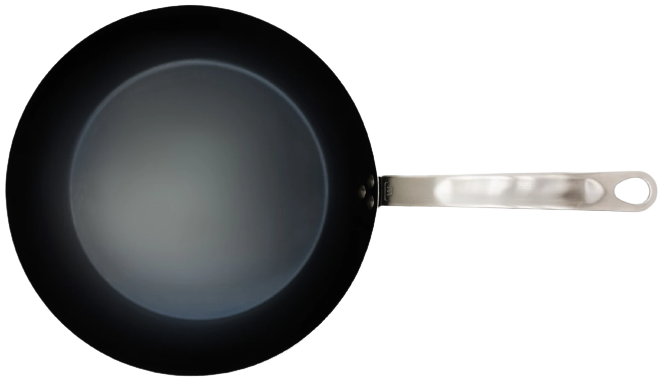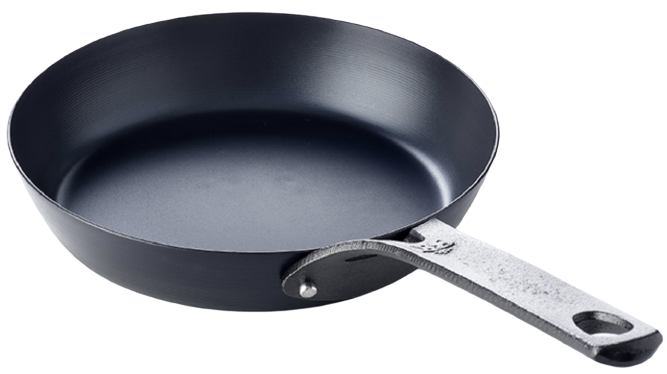When I recently considered buying new carbon steel cookware, I wondered how much it was going to cost. So, I did some research and testing to find out what went into the cost of carbon steel cookware besides marketing hype.
I discovered that the cost of a carbon steel pan or skillet would vary depending on several factors that I listed below. In short, a good carbon steel pan will cost you somewhere between $25.00 and $80.00. Carbon steel cookware outside of this price range does not necessarily provide a greater pan life expectancy or improved cooking results. Almost all carbon steel pans can be left in your Will because they will provide you and your descendants many lifetimes of use.
Advantages of Carbon Steel Cookware:
- Sears Like Cast Iron: A carbon-steel pan can brown food as good as cast iron. Carbon Steel pans have two additional advantages over cast iron: They heat up more quickly, and they are lighter in weight which makes them easier to handle.
- Performs Like Stainless Tri-Ply: Carbon steel pans heat as evenly as stainless-steel tri-ply but can brown deeper.
- Cost Less Than Stainless Steel; Carbon steel cookware costs one-third of the price of the tri-ply skillet from All-Clad.
- As Slick as Nonstick: Carbon steel is as slippery as brand-new nonstick, but it sears better, doesn’t have a synthetic coating, has no oven-safe temperature limits, and lasts forever.
Pre-Purchase Questions:
- Are you considering a French carbon steel pan?
- Are you considering the US-made French-style carbon steel pan?
- What size of a carbon steel pan do you require?
- How thick do you want the sides and bottom of the pan?
- How heavy do you want your pan?
- Do you prefer riveted handles or welded handles?
- What side slope do you want your pan to have?
- Do you want a carbon steel pan or carbon steel skillet?
- Blue or Black Carbon Steel Pan?
- How long do you want your carbon steel handle?
- How high do you want your pan sides to be?
Are you considering a French carbon steel pan?
French carbon steel pans have been manufactured longer than any other type of cookware, except for cast iron cookware. Carbon steel cookware has been manufactured for years and will continue to be manufactured for many years to come.
Those new non-stick pans on the market such as those copper-coated and chemically coated pans will come and go. I doubt that they are around for the amount of time that carbon steel cookware has been.
French carbon steel pans have been around since 1814 and are the leader in the world for manufacturing carbon steel cookware. Carbon steel French-made cookware would be an excellent choice.
Are you considering the US-made French-style carbon steel pan?
Most of my carbon steel pans are made in France. They are excellent. I also have one carbon steel pan that is made in the US and that is my Vollrath pan. My Vollrath pan is great for making omelets. I use it daily just for making eggs. The wall thickness of the Vollrath pan is a bit thinner than the French-made pans. Some say that thinner carbon steel thickness pans have a tendency to warp more than thicker pans.
My Vollrath pan has not warped one bit because I always keep the temperature at a very low temperature when making any egg dishes. Pans can sometimes warp when you apply a high temperature over a long period of time.
From experience, you do not want to choose carbon steel cookware on appearance. For example, when you buy a new stainless steel pan, it will probably look about the same after 5 or even ten years of use.
When you buy a new carbon steel pan, take a picture of it because it will never be the same. The more you use it, the worse it looks. Remember, beauty is in the eye of the beholder.
With carbon steel cookware you do not buy a shiny new pan that will stay shiny for the length of time you use it. It will discolor with use, and that is a good thing because your carbon steel cookware will become more non-stick. It will develop a character all of its own.
When you become the proud owner of carbon steel cookware, you are in possession of a “very functional piece of cookware.” Cooking with carbon steel cookware is like having a symbiotic relationship with it. It is almost like you and your pan talk to each other during the cooking experience. Once you learn how to care for it and cook with it, it will serve you for a lifetime.
What size of a carbon steel pan do you require?
If you planning to buy a carbon steel pan then it is important to pick the right size of pan for your needs. If you are going to cook for yourself, then a small pan might be all that you need. If you are cooking for several people, then you might need a 12 or 14-inch pan. The price difference between the different standard sizes is really quite small.
How thick do you want the sides and bottom of the pan?
The thickness of the sides and bottoms of your carbon steel pan does make a difference. The Vollrath pans usually have thinner metal sides and bottoms as compared to the de Buyer or Matfer Bourgeat pans. If you are going to cook only eggs, then a Vollrath pan would be great because the heat required for preparing eggs is low.
If you want to cook mainly eggs then you might consider getting a pan with round angles at the bottom of the pan. The entire line of Vollrath pans have this angle and they are lightweight which is perfect for cooking any kind of eggs.
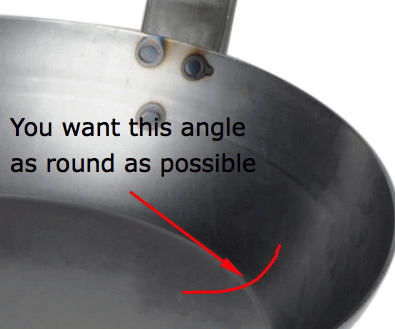
You want a thicker-walled pan when you need to apply higher amounts of heat to help prevent warping of the bottom of the pan.
How heavy do you want your pan?
The heaviest pans are cast iron pans. Second, cast iron pans are carbon steel pans when you are considering the weight of pans. If you have arthritic joints in your hands or arms then I recommend that you look to the Vollrath line of carbon steel pans because they are relatively light compared to other carbon steel pans. Also, if you like to flip the food that you cook, then I would not choose a heavier pan like the de Buyer or Matfer Bourgeat pans.
One important item to note is that the heavier carbon steel pans, like the Matfer Bourgeat or de Buyer pans, regulate heat better than the thinner Vollrath pans.
Do you prefer riveted handles or welded handles?
Some carbon steel pans or skillets have riveted handles. Pans made by de Buyer or Mauviel have riveted handles rather than welded handles. These rivets on the inside of the pan can collect food on them during the cooking process and sometimes these riveted areas can be difficult to clean. I have never really found this to be deciding factor in my buying decision.
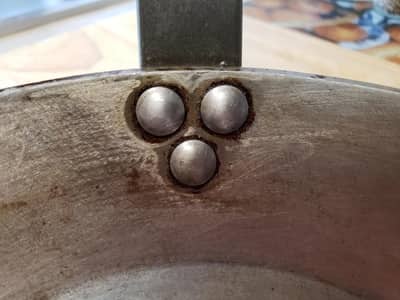
Other pans like the Matfer Bourgeat and Paderno World Cuisine or Vollrath pans have welded handles. I love these pans because it is a breeze to clean and food never sticks to the rivets because there are no rivets. As far as the strength of the handle to the pan, it is just as strong as the riveted handles. It would be extremely hard to break a handle away from the pan itself, in either case.
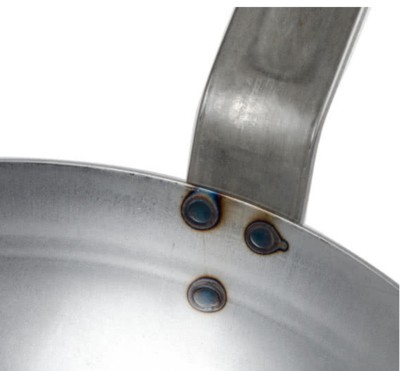
I also have a stainless steel pan which was very expensive and the darn handle keeps coming loose because the handle is attached with screws. You will never have this problem with any carbon steel pan.
What side slope do you want your pan to have?
Each manufacturer of carbon steel pans seems to prefer a different slope to the sides of the pan. A more vertical slope will make it more difficult to get a spatula under your food. Pans like the Matfer Bourgeat have a less vertical angle to the sides of their pans and it is much easier to get a spatula under the food to toss it.
[table id=8 /]
The other day I was preparing a heavy cream sauce for my pork chop and I was using my Matfer Bourgeat pan. As I was mixing the heavy cream, onions, mustard, and brandy around the pan, some of the mixtures splashed out of the pan because the slope of the sides of the pan was not totally vertical.
I transferred that sauce to my de Buyer pan, which had a more vertical sloped side and the problem was solved.
If you are going to make pancakes or eggs, then I recommend the Matfer Bourgeat pan because it is easy to get a spatula under. If you desire a lighter pan than the Matfer Bourgeat, then I would recommend the Vollrath line of pans. When cooking pancakes or eggs, the temperature is relatively low, therefore the Vollrath pan would be a good choice even though the angle of the side is a little more vertical than the Matfer Bourgeat pan.
Do you want a carbon steel pan or carbon steel skillet?
A skillet is a pan with slanted sides. This skillet is also sometimes called a frypan or frying pan. The slanted sides make this perfect for stir-frying and quick cooking techniques where you’re moving ingredients around a lot.
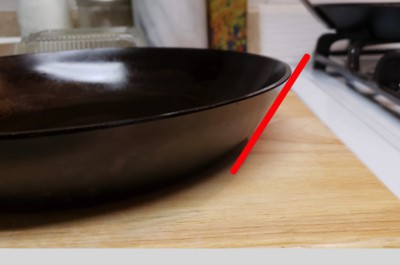
I tend to disagree with this common statement about the usage of a skillet. With slanted sides, as in a skillet, food will have a tendency to splash out as you move the food around in the skillet with a spatula. A pan, with straighter sides, will contain the food more.
The difference between a pan and a skillet is a subtle but important one, and it all comes down to shape.
The du Buyer line of carbon steel cookware could be classified as a pan (straighter sides). The Matfer Bourgeat line of cookware could be classified as a skillet (slanted sides).

Vollrath pans (below) lie between a pan and skillet. Vollrath carbon steel pans can be used as a skillet or pan because of the slope of the sides.
Blue vs Black Carbon Steel Pan
When shopping for carbon-steel pans, you’ll see references to “blue steel” and “black steel” pans or skillets. These terms usually refer to hardening treatments that help prevent rust on the surface of the pans. This hardening treatment to the pans or skillets leaves the surface of new pans looking either blue or black rather than shiny silver color.
Pre-Seasoned Blue Carbon Steel by Made-In.
The same carbon steel you love, but with a layer of seasoning already applied to your pan. With its cast iron’s heat retention and stainless steel’s lightness–carbon steel is the perfect hybrid between two cooking surfaces: one for searing meat or frying up some eggs in minutes while the other cook’s delicate sauces slowly over low heat without burning them. It has been used by professional chefs for centuries so it’s time we bring this old favorite to our kitchens!
I usually use the “black steel” pans and season them myself. Over a period of time, sometimes the “blue steel” pans need to be seasoned which is no big deal. Both pans in the end to a great job and you won’t go wrong by choosing either one.
How long do you want your carbon steel handle?
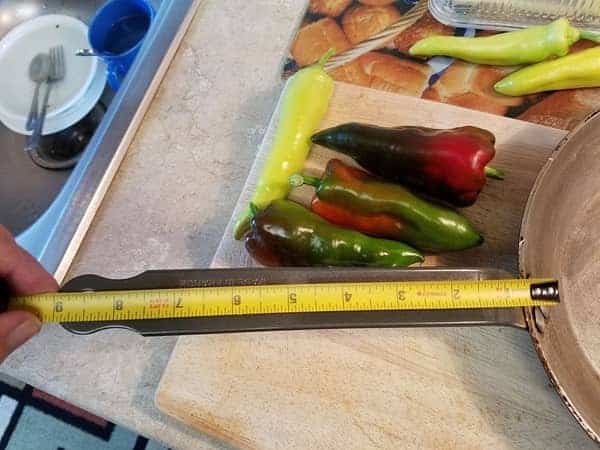
One other important thing to consider when purchasing a pan is that you should realize that long handles on pans do not get as hot as shorter handles. Matfer Bourgeat has a much shorter handle than the du Buyer pans so it will get hotter. On the other hand, the Matfer Bourgeat handle stores easier in your oven because it is shorter and not as high as some of the other manufacturers of carbon steel cookware
How high do you want your pan sides to be?
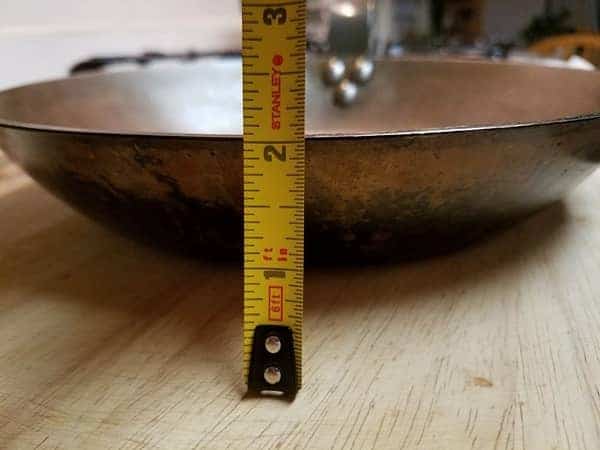
The height of the sides on a carbon steel pan is important in only a few instances. If you are cooking eggs, pancakes, or crepes, you will want a pan with low-sloping sides like the Matfer Bourgeat skillet. Since the sides are sloped more than other pans and lower in height, it will be easier to get under your food to turn it over.
Should You Really Look at the Price of Carbon Steel Cookware?
The price of carbon steel pans should be the second question rather than the first. How you are going to use your carbon steel pan should be more important than the price. We know that the price can be, on average, between $25.00 and $100 so let’s put that aside for right now.
How are you planning to use your carbon steel pan is more important. If you have one person to cook for or 5 people to cook for, then it does make a difference in the size of the pan needed. So, in this case, the size of the pan is more important than just the price. It would be very difficult to cook for 5 people on a $25.00 6-inch pan.
If you are going to use your pan for searing steaks or pork chops then you will need a pan with thicker construction. A de Buyer pan or Matfer Bourgeat pan would be great because they have thicker sides and will not warp as easily as a thinner-walled pan such as the Vollrath line of pans. I am not saying that the Vollrath pans are not good. I have a Vollrath pan and use it daily for making omelets. My Vollrath pan is non-stick and is great for frying eggs.
What is Blue Carbon Steel?
Bluing is a chemical process for coating carbon steel to prevent rust from forming and has nothing to do with the steel’s composition. Blue carbon steel is still composed of 1% carbon and 99% iron. The black carbon steel also contains 1% and 99% iron.
The French know how to make a quality pan. Blue carbon steel is the perfect choice if you’re looking for something that can resist rust and corrosion! The pans are made by people who have been making them their whole lives, in France which has some of the best heat treating processes on Earth because they’ve got centuries-worth of practice under their belts (literally).
What is High Carbon Steel?
Metallurgists define high carbon steel as being iron mixed with over 0.8% carbon but less than 2.11% carbon in its composition. The average level of carbon found in this metal usually falls right around the 1.5% mark. High carbon steel is especially hard. The extra carbon makes it more brittle than other types of steel. This type of steel is the most likely to fracture under stress and cannot easily be welded or bent like lower quality steel. Many forged carbon steel knives have cutting edges of high carbon steel.
Recommended Reading
Best Reasons Not To Use Rusted Cookware
Did you know that cooking with rusted cookware can cause lead to leaching into your food? Here’s why you need to think twice before using a rusty pan. It is important to find a product that you can use for effective cookware rust removal.
Best Carbon Steel Pan for Cooking Eggs
This Vollrath carbon steel fry pan is perfect for frying, sauteing, searing, scrambling, and more! Carbon steel is an excellent conductor of heat, making it a favorite for high-temperature cooking. Once seasoned, this French-style fry pan distributes heat evenly for a fast, uniform cook. It’s ideal for any home or commercial kitchen and can be made NON-STICK by seasoning it correctly.
Carbon Steel Pans vs Cast Iron Pans
Carbon steel and cast iron pans can be considered cousins. It means that they have quite some similarities but some characteristics are used to differentiate the two. Carbon steel heats up and cools down quicker. Cast iron is slow to heat up and slow to cool down. Each has advantages
Why are Eggs Sticking to My Carbon Steel Pan?
Eggs can stick to your carbon steel pan for several reasons. The pan could be too cold, too hot, not enough butter or oil, cold eggs, incomplete seasoning, and a variety of other reasons. Take a few minutes to reveal what I have discovered about eggs sticking to the bottom of carbon steel pans.
Cast Iron Pans vs Carbon Steel Pans
Which pan is better for you? Learn more about the differences between cast iron s and carbon steel pans. They are both made from metal, so you can expect them to be durable. Both of them are safe to put in the oven and they can handle a wide variety of foods on your stove.
How to Clean a Rusted Carbon Steel Pan the Right Way
If you have rust on your carbon steel cookware or wok, I will show you a step-by-step procedure for removing that rust and re-seasoning your carbon steel cookware. I will also show you how to store and protect your cookware from rust.
